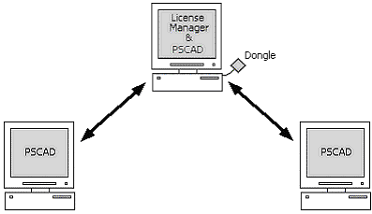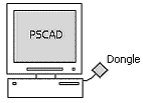
License Key/License Database File
With lock-based licenses, validation is achieved through the installation of a database file and hardware lock. Licenses are organized and controlled using license manager software, which can exist as either a separate, standalone service, or embedded within the PSCAD application itself.
Lock-based licenses come in two different styles: Multi-user and single-user. The style that is best for your purposes depends on how PSCAD is to be utilized, as well as on what type of license(s) you purchased. The following sections describe each type of lock-based license in detail.
Multi-user licenses (MUL) were first introduced with PSCAD V3 and were, at the time, the only license type available. With this configuration, the license manager software is installed as a standalone service, which can be accessed by any workstation (including the host) on a Local Area Network (LAN).
NOTE: The license manager can only license client workstations that reside on the same network as itself, and where the network is constrained by its network class (the term network class is defined by RFC-960, which is part of the Internet Protocol Standards). The subnet masks on the license manager and client workstations may need to be adjusted, so that the client can contact the license manager workstation. A new configuration, called Expanded Licensing, is available to allow a license manager to license clients across two networks. Expanded licensing is available for free, and requires License Manager v1.30 or later. This licensing is temporary but renewable, and expires after three years for an Educational Edition, or at the end of a maintenance contract for a Professional Edition.
A multi-user license set-up is capable of providing multiple users on multiple workstations the ability to run multiple combinations of various licensable editions of PSCAD. In other words, if a user is sufficiently licensed, this method has the potential to afford a lot of freedom when operating over a LAN, and should be used if there will be two or more users running PSCAD simultaneously.
The license manager is used in conjunction with a hardware lock (also known as a USB lock or dongle), which contains licensing information for the purpose of validation. When an instance of PSCAD is started somewhere on the LAN, a license will be requested from the license manager. The license manager determines whether a license is available, and checks the information on the dongle for verification.
The number of users that can access PSCAD simultaneously over the LAN depends on the number of licenses purchased. For example, if there are a total of two Professional Edition licenses, then only two users may use the Professional Edition at the same time, or one user may use two instances of PSCAD on his or her workstation. Each time a user opens or closes the application, it will request or relinquish a license respectively. Each licensable edition possesses a separate product number, so that several products can be licensed by the same license manager.
NOTE: The number of licenses owned does not limit the number of PSCAD installations on the LAN. You can install PSCAD on every workstation in your organization if you wish.
The license manager and dongle need be installed only on one workstation in a network. This workstation will act as the license manager server, which will grant licenses to other workstations on the network, as requested. PSCAD may also be installed on the license manager server workstation if desired.

EXAMPLE: A user owns one Professional Edition license containing three PSCAD seats, all of which are programmed onto a single hardware lock. The three PSCAD seats refer to a maximum of three instances of PSCAD that may be run at the same time. The above diagram illustrates how the user could install the license manager on a LAN, so that up to three users can run PSCAD simultaneously.
Multi-user licenses can be time limited or permanent (no time limit).
A single-user license (SUL) involves the use of a hardware lock, but a standalone license manager service is not required. An embedded license manager within the PSCAD application itself manages the single-user license.
A single-user license will only allow a single user on a single workstation to run only one instance of a licensable software edition. A single-user license is designed specifically for use on standalone workstations, and will NOT allow access from others.

EXAMPLE: A user owns one Professional Edition single-user license programmed onto a single hardware lock. The above diagram illustrates how the user would install PSCAD as a single-user configuration. Note the absence of the license manager as a separate program.
Single-user licenses can be time limited or permanent (no time limit).
The License Manager software for both single-user and multi-user licensing supports the following hardware lock in lock-based licensing:
|
Sentinal SuperPro™ USB, USB Port Hardware Lock |
The USB hardware lock is compatible with all Windows platforms on which PSCAD is supported.
The license key is an ASCII text file named license.txt. The license key is used with both single-user and multi-user licenses, and is required for both the Professional and Educational Editions. This file contains encrypted information designed to act as a key to adding or upgrading a license on a workstation, specifically by creating and updating a license database file. Together, the hardware lock and license database file are used directly by either the standalone license manager or self-licensing to validate a request for a license.